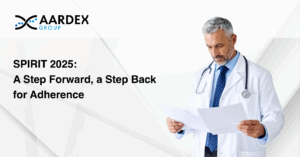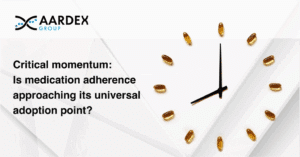Poor adherence to medication has been costing lives and money for decades – but cutting-edge solutions are now on hand to solve the age-old problem.
It is no secret that the medical community has a problem with patient compliance: patients not taking their medication as prescribed. The issue drives health outcomes down, forces cost up[1], and has been well documented over the last few decades. How to deal with the issue, however, is less clear-cut. Many current measures are imperfect, biased, and inaccurate, and the huge variety of barriers to compliance rule out a one size fits all solution.
A new generation of smart packaging is providing researchers with the ability to take an informed, patient-centered approach, and overcome the adherence puzzle once and for all.
Avoidable Mortality and Morbidity
Prescription drugs can offer life-changing results, but they only work if people take them as prescribed. That is not always easy, especially for people with long-term conditions who require regular, ongoing treatment to prevent disease progression or complications. The consequences can be dire. A study of more than 65,000 people with Type 2 diabetes, for example, found poor medication adherence in the two years after diagnosis was associated with an increased risk of all-cause mortality and cardiovascular disease (CVD). It raised the mortality rate by 45%, and the incidence of CVD by 41%.[2]
“Interventions to improve medication adherence to a maximum level may reduce the five-year cumulative mortality rate from 7.46% to 5.06% among patients with poor medication adherence,” said the authors, adding that such a move could prevent 240 deaths and 152 cases of CVD per 10,000 people.
Another paper looked at the association between poor adherence and poor outcomes in hypertension, diabetes, and hyperlipidemia. Using data from the Korean National Health Insurance Claims Database, the authors defined poor adherence as being less than 80% of medication possession ratio (MPR), a pill count method based on prescription refill volumes, over 12 months.[3]
It found that hypertensive patients with poor adherence were 10.9% more likely to experience disease-specific hospitalizations than their adherent counterparts within two years. What’s more, the likelihood of all-cause hospitalization was higher among patients who had poor medication adherence across all groups. People with hypertension and an MPR of less than 80% were 32% more likely to need hospital treatment within two years than those with an MPR of more than 80%. That figure was 16% in hyperlipidemia and 32% in diabetes.
As these studies illustrate, people can pay the ultimate price for not taking their medication as prescribed – across Europe, medication non-adherence contributes to an estimated 200,000 premature deaths every year.[4]
Avoidable Costs
Aside from the devastating human costs, poor adherence costs the sector millions in terms of healthcare costs and lost revenues. According to the New England Healthcare Institute, medication non-adherence is responsible for around $100bn in excess hospitalizations every year.[5]
The report said this increased risk of hospitalizations due to poor health outcomes translates to significant excess costs.
Several studies have found that overall healthcare costs are much higher for patients with poor adherence. For example, among diabetes patients, those with high levels of adherence had total annual healthcare costs of $8,886 while patients with low levels of adherence had almost twice the total annual healthcare costs, totaling $16,498.
The costs to drug developers and manufacturers are equally eye-watering. A 2018 report estimated that non-adherence costs the global pharmaceutical industry $564bn every year.[6]
Not only does the problem have a direct impact on revenue in terms of unfilled prescriptions, but it also reduces the perceived value of efficacious products that have been meticulously developed and diligently brought to market.
Interventions to improve medication adherence should be a top priority for the pharmaceutical industry and will prove beneficial to all stakeholders.
Increasing adherence rates by only 10 percentage points would translate into a $41 billion pharmaceutical revenue opportunity in the US, and $124 billion globally, accompanied by improved health outcomes and decreased healthcare spending. 6
Medication Adherence in Drug Development Trials
In product development, non-adherence to study medications can result in drug efficacy being underestimated to the point of trial failure, compromise patient safety, and complicate regulators’ benefit-risk assessments.[7]
Studies show that each Phase III trial participant is responsible for an average of $42,000 in costs[8], yet almost a third, 30%, are non-adherent by day 100.7 Across all clinical trial phases, 50% of participants admit to not adhering to the dosing regimen set out in the protocol.[9]
It drains study power and has a direct effect on the cost and duration of clinical trials. Crucially, it can delay the approval of investigational products – at a cost of between $600,000 and $8million a day in lost revenues.[10]
Medication Adherence Measures
Over the years, the industry has developed several measures for monitoring and mitigating the risks of poor medication adherence.
Measures tend to include direct methods, such as observing therapy intake or measuring blood or urine titer levels. Indirect methods, such as patient questionnaires and self-reporting, pill counts and rates of prescription refills, or the assessment of clinical responses or physiologic markers, are also common.
For more than four decades, lots of research on how to properly measure and quantify medication adherence has been conducted but none… can be counted as the gold standard.
A review of the measures published in 2015 quoted that different tools have been designed and validated for different conditions, in different circumstances.1
What’s more, traditional measures have inherent limitations – they can be subjective or inaccurate. In many cases, they provide just a yes/no answer, rather than actionable insight into the reasons behind the problem.
In addition to the absence of a reliable, “one size fits all measure”, the industry also lacks a universal, effective intervention.
Barriers to Medication Adherence
Barriers to medication adherence, which might be intentional or non-intentional, are multiple. The problem might be socioeconomic, or it might be related to the therapy, the condition, or the patient. It could stem from the relationship between the person and their healthcare team, or a lack of health literacy.
Each reason requires a bespoke, person-centered, tailored intervention. Some people might need additional education or behavioral counseling. Others may benefit from an improvement in communication between them and their healthcare team, while some might simply need to be reminded.
This complexity of joining accurate measurements to effective interventions means that, to date, overcoming the adherence conundrum has proved elusive.
Smart Packaging, the Missing Link in the Medication Adherence Puzzle
Solving the medication adherence puzzle involves a two-step approach: accurate measurement followed by appropriate management. Electronic monitoring, widely recognized as the most objective and precise form of medication adherence monitoring, is the key to step one.
Smart packaging, which can accurately record dosing events, is now available for a wide range of administration routes. Smart pill bottles, smart pills, smart blister packs, reusable topical treatment caps, and tubes, smart inhalers, smart injectable therapy containers are all part of a new generation of medication adherence tools.
They feature an electronic microcircuit that automatically generates a timestamp every time the patient takes or applies their medication. This information is stored on the packaging’s memory before being wirelessly transferred to a central, cloud-based software system for analysis and interpretation.
Smart packaging enables healthcare teams and researchers to map real-life, rather than estimated, adherence, over time and provides accurate, objective results. But such devices cannot solve the puzzle alone. By connecting this cutting-edge hardware to cutting-edge software, we can drill down into medication behaviors to understand habits, detect issues, and recommend appropriate interventions.
Data visualization and algorithms can spot typical behavior changes, such as drug holidays, weekend drop-offs, and different intake times. They offer insight on whether such changes are “one-offs” or might be cause for concern.
Armed with this information, healthcare teams and researchers can quickly detect potential problems, and work with patients to provide individual advice and develop appropriate interventions.
Next-Generation Medication Adherence Tools
Advanced digital monitoring provides complete oversight of the adherence metrics and risk indicators that matter the most. Studies have shown that smart electronic packaging and device monitoring is 97% accurate. That compares to 70% accuracy for drug levels and markers, 60% for pill counts, 50% for healthcare professional ratings, and just 27% for patient self-reporting, including electronic patient diaries.[11]
Smart packaging is passive and frictionless, placing no burden on the patient. That makes it more effective than app-based methods, which introduce additional tasks to the medication routine, and tend to struggle to obtain accurate data from those most at risk from non-adherence.
Smart packaging creates an ecosystem that joins measurement and intervention – a closed feedback loop that can optimize medication efficacy, maximize outcomes, and reduce unnecessary costs for healthcare systems and industry players alike.
Ultimately, it can help people to live longer, healthier lives while ensuring maximum return on investment for drug developers and manufacturers.
[1] Lam, WY., Fresco, P. Medication Adherence Measures: An Overview. (2015). https://www.ncbi.nlm.nih.gov/pmc/articles/PMC4619779/
[2] Kim, YY., Lee, JS. et al. Effect of medication adherence on long-term all-cause-mortality and hospitalization for cardiovascular disease in 65,067 newly diagnosed type 2 diabetes patients. (2018). https://www.ncbi.nlm.nih.gov/pmc/articles/PMC6093904/
[3] Han, E., Suh, DC., et al. The impact of medication adherence on health outcomes for chronic metabolic diseases: A retrospective cohort study. (2014). https://www.sciencedirect.com/science/article/abs/pii/S1551741114000254?via%3Dihub
[4] OECD. Investing in medication adherence improves health outcomes and health system efficiency. (2018). https://www.oecd-ilibrary.org/social-issues-migration-health/investing-in-medication-adherence-improves-health-outcomes-and-health-system-efficiency_8178962c-en
[5] New England Healthcare Institute. Thinking outside the pillbox: A System-wide Approach to Improving Patient Medication Adherence for Chronic Disease. (2009). https://www.nehi.net/writable/publication_files/file/pa_issue_brief_final.pdf
[6] Cap Gemini Consulting. Estimated annual pharmaceutical revenue loss due to medication non-adherence. (2018). https://www.capgemini.com/wp-content/uploads/2017/07/Estimated_Annual_Pharmaceutical_Revenue_Loss_Due_to_Medication_Non-Adherence.pdf
[7] Blaschke, T, Osterberg, L., et al. Adherence to medications: insights arising from studies on the unreliable link between prescribed and actual drug dosing histories. (2011). https://pubmed.ncbi.nlm.nih.gov/21942628/
[8] Sertkaya, A., Birkenbach, A., et al. Examination of clinical trial costs and barriers for drug development. (2014). https://aspe.hhs.gov/system/files/pdf/77166/rpt_erg.pdf
[9] Eliasson, L., Clifford.., S. et al. How the EMERGE guideline on medication adherence can improve the quality of clinical trials. (2020). https://bpspubs.onlinelibrary.wiley.com/doi/full/10.1111/bcp.14240
[10] Hargreaves, B. Clinical trials and their patients: The rising costs and how to stem the loss. (2016). http://www.pharmafile.com/news/511225/clinical-trials-and-their-patients-rising-costs-and-how-stem-loss
[11] Vrijens, B., Urquhart, J. Methods for measuring, enhancing, and accounting for medication adherence in clinical trials. (2014). https://pubmed.ncbi.nlm.nih.gov/24739446/
About the Author
Bernard holds a PhD from the Department of Applied Mathematics and Informatics from Ghent University, Belgium. As Scientific Lead at AARDEX ® Group, Bernard oversees the research and development of sophisticated analytical methods for monitoring participant medication-taking behaviours.
Along with providing guidance on adherence to Pharmaceutical, BioPharma, and Academic organizations, Bernard is a founding member of the International Society for Patient Adherence (ESPACOMP) and is an active member of several EU and US-funded consortiums that focus on adherence. Having co-authored several book chapters, over 100 peer-reviewed scientific papers, Bernard is considered an expert in his field.



